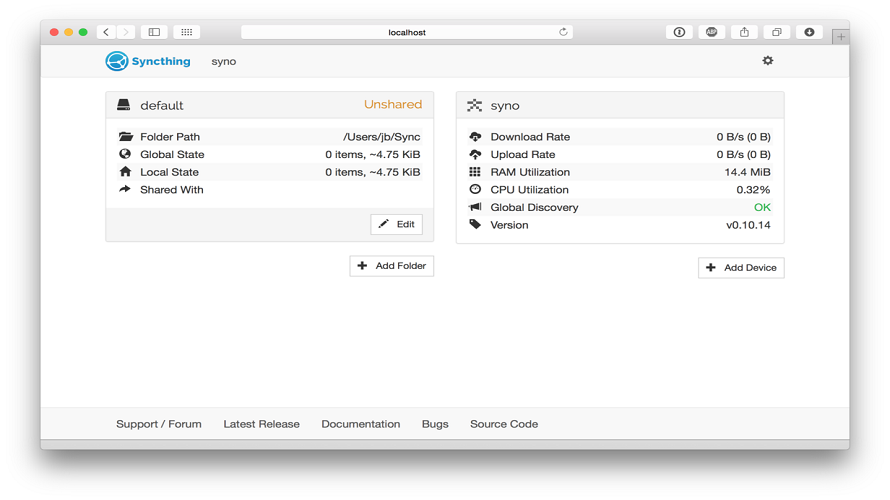Help & Support¶. For information on and support for Syncthing itself, please refer to the Syncthing documentation and the Syncthing forum. For issues with the Synology packaging of Syncthing specifically, or with this documentation itself, please open an issue on the syncthing-synology GitHub repository. Syncthing only syncs when you connect for a brief period, as ios doesn’t permit a daemon running full time in the background. Another limitation of the ios operating system is it does not allow me to open a file directly, but I must import it into the app. Next, on Syncthing B, there will be a new call-to-action at the top of the page. This is a request for you to allow Syncthing A to add Syncthing B as a device. Simply click Add. Then, shortly after accepting the new device, you'll get another popup which is Syncthing A requesting to share the folder you have just create. Syncthing is a continuous file synchronization program. It synchronizes files between two or more computers in real time, safely protected from prying eyes. Your data is your data alone and you deserve to choose where it is stored, whether it is shared with some third party, and how it's transmitted over the internet. The default folder '/config' of Syncthing binds.
Another way to backup mobile photos to a headless server, besides using Google Photos.
I am running a Ubuntu 20.04 server on a Raspberry Pi 4 and trying to use Syncthing (supports Windows, Mac, Linux, and Android) to backup my mobile photos. Following is notes on steps:
Installing Syncthing
Ref: https://apt.syncthing.net/ and https://www.linuxbabe.com/ubuntu/install-syncthing-ubuntu-desktop-server

Configuring to allow external access
Syncthing Docker
Ref: https://docs.syncthing.net/users/faq.html#how-do-i-access-the-web-gui-from-another-computer
The syncthing systemd service creates configuration files under /home/username/.config/syncthing/ and a folder /home/username/Sync as the default sync folder. The main config file is /home/username/.config/syncthing/config.xml.
Now we need to modify the config.xml file
to change 127.0.0.1:8384 to 0.0.0.0:8384
Enable the service at system start
Ref: https://docs.syncthing.net/users/autostart.html#using-systemd
There are two types of services that can be enabled: system service and user service.
Running Syncthing as a system service ensures that Syncthing is run at startup even if the Syncthing user has no active session. Since the system service keeps Syncthing running even without an active user session, it is intended to be used on a server.

Running Syncthing as a user service ensures that Syncthing only starts after the user has logged into the system (e.g., via the graphical login screen, or ssh). Thus, the user service is intended to be used on a (multiuser) desktop computer. It avoids unnecessarily running Syncthing instances.
I am planning to set up the system service:
(NOT necessary for Ubuntu >=18.04) From git location mentioned above copy the
Syncthing/etc/linux-systemd/system/syncthing@.servicefile into the load path of the system instance. [/lib/systemd/system/]Enable and start the service. Replace “ubuntu” with the actual Syncthing user after the @:
Then we can check the status of the servie:
Accessing the Web interface (GUI) from another computer
The address is by default: [server IP]:8384
Syncthing Vs Resilio
Should set a password and enable HTTPS.
Syncthing Synology
More to read: the FAQ of Syncthing

